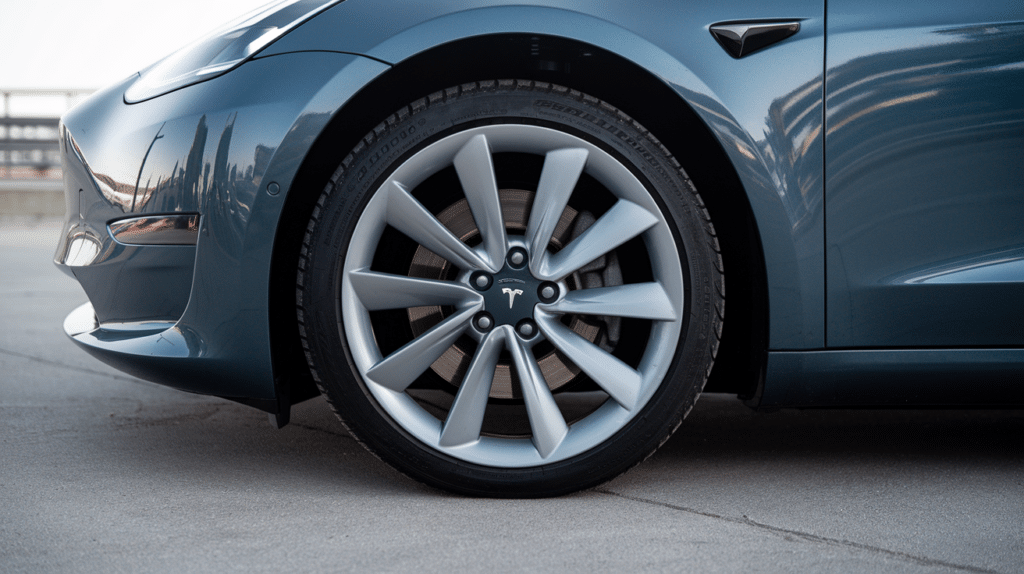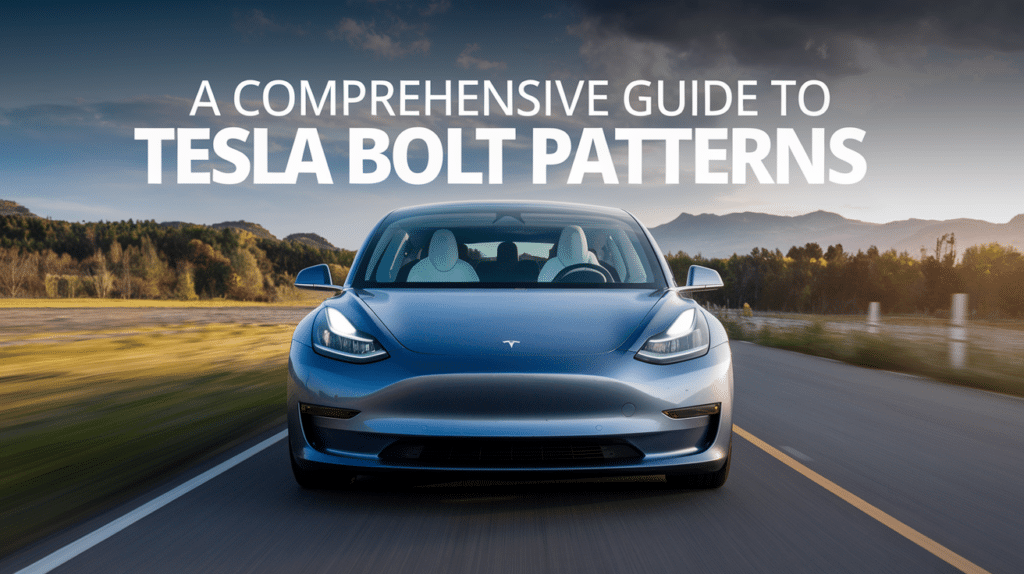Ever stared at your Tesla’s wheels, wondering why those aftermarket rims you bought online just won’t fit?
I’ve been there, and trust me, getting the wrong bolt pattern can be a $1000+ mistake that’ll leave you frustrated and wallet-lighter.
In this blog, I’m sharing A Comprehensive Guide To Tesla Bolt Patterns that’ll save you from costly wheel-fitting disasters. After spending years working with different Tesla models and helping countless owners, I’ve gathered everything you need to know in one place.
By the time you finish reading this, you’ll confidently know exactly which wheels fit your Tesla, understand those confusing bolt pattern numbers, and never waste money on incompatible wheels again.
Plus, I’ll share some insider tips on finding the best ways to identify perfectly-fitting wheels.
What Is the Bolt Pattern for A Tesla?

The Tesla bolt pattern, also known as the wheel fitment or lug pattern, varies depending on the specific Tesla model. For the Model 3 and Model Y, Tesla uses a 5×114.3mm bolt pattern, which means there are 5 lug nuts arranged in a circle with a diameter of 114.3 millimeters. This is a common pattern shared with many other vehicles.
The Model S and Model X, however, use a 5x120mm bolt pattern, meaning the five lug nuts are arranged in a slightly larger circle with a 120-millimeter diameter.
It’s important to note that when choosing aftermarket wheels, you’ll need to match this bolt pattern exactly.
The center bore (the hole in the middle of the wheel) is also important – Tesla uses a 64.1mm center bore for Model 3/Y and a 64.1mm or 72.6mm center bore for Model S/X, depending on the year.
Understanding Tesla Bolt Patterns and Their Compatibility
Each Tesla model has specific center bore requirements: Model 3 and Model Y use a 64.1mm center bore, while Model S and Model X can have either 64.1mm or 72.6mm depending on the manufacturing year. Using wheels with the wrong center bore size can cause vibration and poor handling.
When considering winter or aftermarket wheels, it’s crucial to match both the bolt pattern and center bore size. Hub-centric rings can be used to adjust center bore sizes, but the bolt pattern must match exactly.
1. Tesla Model 3 and Model Y
The Tesla Model 3 and Model Y share a 5×114.3mm bolt pattern, making their wheels interchangeable between these two models. This pattern is also common among Japanese and Korean vehicles, offering wider aftermarket wheel options.
2. Tesla Model S and Model X
Tesla Model S and Model X use a 5x120mm bolt pattern, which is different from the Model 3/Y.
This means wheels from Model 3/Y cannot fit on Model S/X and vice versa without using adapters. This pattern is similar to what BMW and some other European manufacturers use.
A List of Correct Bolt Patterns for Different Tesla Models
| Tesla Model | Year Range | Bolt Pattern | Center Bore | Lug Count |
|---|---|---|---|---|
| Model 3 | 2017-2024 | 5×114.3mm | 64.1mm | 5 |
| Model Y | 2020-2024 | 5×114.3mm | 64.1mm | 5 |
| Model S | 2012-2020 | 5x120mm | 72.6mm | 5 |
| Model S | 2021-2024 | 5x120mm | 64.1mm | 5 |
| Model X | 2015-2020 | 5x120mm | 72.6mm | 5 |
| Model X | 2021-2024 | 5x120mm | 64.1mm | 5 |
| Cybertruck | 2024 | 6×139.7mm | 78mm | 6 |
Additional Information:
- All measurements are in millimeters (mm)
- The first number in the bolt pattern (5 or 6) indicates the number of lugs
- The second number (114.3, 120, or 139.7) indicates the diameter of the circle formed by the lug holes
How to Identify the Correct Bolt Pattern for A Specific Tesla Model?
1. Check Your VIN (Vehicle Identification Number)
- Look up your VIN on your vehicle registration or find it on your car’s dashboard near the windshield, The 10th character in your VIN tells you the model year
- Once you have the year and model, cross-reference with the bolt pattern table I shared earlier
- Pro tip from my experience: Take a photo of your VIN so you always have it handy!
2. Use the Manual Method (The DIY Approach)
- First, safely lift your car and remove one wheel
- Count the number of lug nuts (most Teslas have 5, except Cybertruck which has 6)
- Measure the distance between two opposite lug holes (center to center)
- Remember: Model 3/Y will measure 114.3mm, while Model S/X will be 120mm
- I recommend using a proper measuring tool rather than eyeballing it – trust me, I learned this the hard way!
3. Tesla Mobile App Info
- Open your Tesla mobile app and go to the ‘Vehicle Info’ section
- Look for wheel specifications under vehicle details
- This is especially helpful for newer Tesla models (2020 and later)
- Bonus tip: Screenshot this info for future reference when shopping for wheels
4. Physical Measurement Tool (Bolt Pattern Gauge)
- Invest in a bolt pattern gauge (around $20-30 at auto parts stores)
- Place it over your wheel hub while the wheel is still on
- The gauge will give you an exact reading
- This is my go-to method when helping friends identify their patterns
- It’s worth the investment if you plan to buy aftermarket wheels
5. Online VIN Decoder (The Tech-Savvy Way)
- Visit Tesla’s official website or trusted VIN decoder sites and enter your full VIN number
- Look for wheel specifications in the detailed breakdown
- Double-check the information against your owner’s manual
- I always recommend saving the decoded information as a PDF on your phone
Remember: Always verify the measurements twice. It’s much better to spend an extra few minutes double-checking than to order the wrong wheels and deal with returns!
Comparisons Between Tesla’s And Other Brands’ Bolt Patterns With Prices
| Brand & Model | Bolt Pattern | Center Bore | OEM Wheel Price Range* | Compatible with Tesla? |
|---|---|---|---|---|
| Tesla Model 3/Y | 5×114.3mm | 64.1mm | $250-450/wheel | – |
| BMW 3/5 Series | 5x120mm | 72.6mm | $300-600/wheel | Model S/X (with hub rings) |
| Audi e-tron | 5x112mm | 66.6mm | $400-800/wheel | No |
| Porsche Taycan | 5x130mm | 71.6mm | $600-1,200/wheel | No |
| Mercedes EQS | 5x112mm | 66.6mm | $500-900/wheel | No |
| Rivian R1T/R1S | 6×139.7mm | 77.8mm | $400-700/wheel | Cybertruck only |
| Lucid Air | 5×114.3mm | 64.1mm | $550-950/wheel | Model 3/Y |
| Polestar 2 | 5x108mm | 63.4mm | $300-500/wheel | No |
Additional Information:
- Price ranges are approximate for original equipment (OEM) wheels as of 2024
- Aftermarket wheels typically cost 20-40% less than OEM
- Using adapters to fit incompatible patterns isn’t recommended due to safety concerns
- Price varies significantly based on wheel size, design, and material (alloy vs. forged)
- Most manufacturers offer both standard and performance wheel options at different price points
How to Maintain Your Tesla’s Bolt Patterns
Regular Inspection & Cleaning
- Remove each wheel every 6 months to clean the mounting surface and bolt holes thoroughly and Inspect for any signs of corrosion, rust, or damage around the lug holes and center bore
Proper Torque Maintenance
- Retorque lug nuts to manufacturer specifications after the first 100 miles of installing new wheels
- Use a calibrated torque wrench rather than an impact gun to prevent over-tightening
Lug Nut Care
- Replace lug nuts if they show signs of thread wear or damage
- Avoid using chrome-plated lug nuts as they can cause uneven pressure distribution
Hub-Centric Ring Management
- If using hub-centric rings, check them for deformation or damage every time you rotate tires. Also, Clean and lubricate hub-centric rings with appropriate grease to prevent sticking
Anti-Seize Application
- Apply a thin layer of anti-seize compound on the hub surface (not on threads)
- Clean and reapply anti-seize compound annually to prevent wheel bonding to the hub
Winter Care
- Apply protective coating to bolt patterns if you live in areas with heavy road salt use
- Remove accumulated salt and debris from lug holes at least monthly during winter
Professional Inspection
- Have a certified Tesla technician inspect wheel mounting surfaces annually and make sure to Document any repairs or modifications to maintain warranty coverage and resale value
Conclusion
Listen, I know bolt patterns can seem like rocket science at first (ironic, since we’re talking about Tesla), but I hope this guide has demystified things for you.
From my years of experience, I can’t stress enough how crucial it is to get these measurements right.
If you’re rocking a Model 3 or cruising in a Cybertruck, you now have the knowledge to make informed wheel decisions.
Remember: When in doubt about your Tesla’s bolt pattern, take the extra minute to measure twice. Write measurements down, save them on your phone, or bookmark this page – they’ll come in handy when you’re wheel shopping. It’s way better than dealing with returns or, worse, compromising your vehicle’s safety.
And hey, if you’re still unsure, drop a comment below or consult your local Tesla service center – sometimes a second opinion is all you need.
Stay charged, and happy rolling!


